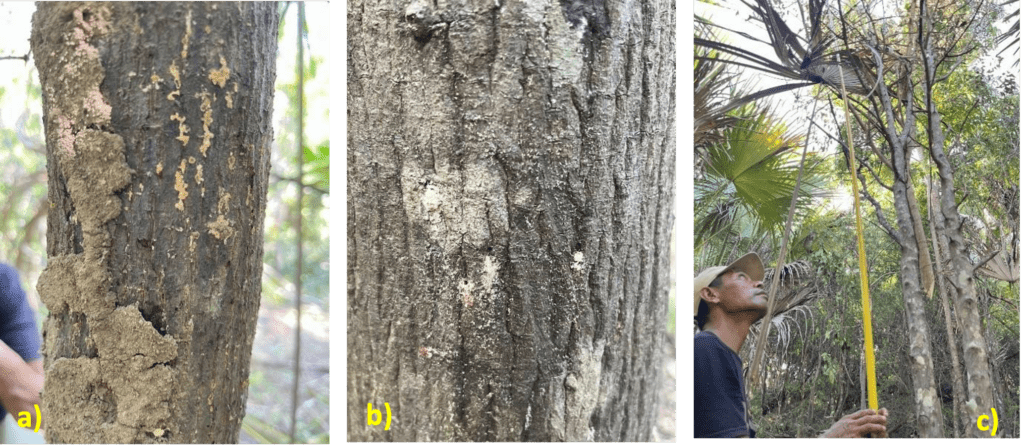

Assessing Sandalwood Agroforestry Systems in Timor-Leste
September 10, 2024
The Crawford Fund’s highly sought after Student Awards are one way we support and encourage the next generation of Australians into study, careers and volunteering in international agricultural research.
The awards are funded by our State and Territory Committees and made possible by organisations including ACIAR, international centres, Australian and overseas universities and NGOs who host our awardees.
We would like to share the experience of Duc Bui a PhD student from the Forest Research Institute (FRI) at the University of the Sunshine Coast (UniSC) who travelled to Timor-Leste to assess the influence of host species and environmental factors on growth and heartwood development of sandalwood in agroforestry systems.

This project, in collaboration with the ACIAR Ai-com project, conducted field visits to four sites in Timor-Leste where sandalwood (Santalum album) is grown in mixed configurations with native species. The study focuses primarily on the Clacuc site to assess challenges and opportunities in sandalwood plantations.
Sandalwood thrives in both tropical and temperate environments, with 16 recognised species distributed across a vast geographical range. The extraction of oil from sandalwood heartwood has made it a prized resource in the fragrance and cosmetic industries. Recent research has also unveiled diverse applications of sandalwood oil in pharmaceuticals, food, and biomedicine. Beyond industrial applications, sandalwood trees offer a range of benefits, including support for reforestation initiatives, and enhancement of local land management practices.
“The range of potential prospects offered by sandalwood production presents significant opportunities for agribusiness investments, generating regional employment, and improving the income of subsistence farmers,” said Duc.
The variations in heartwood volume and oil quality among sandalwood species has a significant impact on their exploitation and utilisation and influences both their natural distribution and plantation cultivation he explained. The two most well-known sandalwood species, Santalum album and S. spicatum, are categorised as vulnerable species in their natural habitats and are cultivated on large-scale plantations in Australia, India, and China, as well as by smallholders in other regions (e.g. Timor-Leste, Vietnam).
According to Duc, recent research indicates that factors such as host species, environmental conditions, genetic sources, and the interactions between these factors affect tree growth, heartwood formation, oil volume and oil quality in sandalwood species. However, there is still limited understanding of these dynamics. Additionally, knowledge gaps persist regarding the optimisation of growth, pest management, and silvicultural practices for these species.
“In Timor-Leste, S. album naturally occurs, predominantly in monsoon dry mixed tropical forests. These forests are uniquely adapted to endure prolonged dry seasons. As the number of wild sandalwood trees dwindles, there has been growing interest in cultivating this species as a commercial agroforestry crop,” he said.
The integration of sandalwood with other crops or native trees in agroforestry systems presents significant challenges, primarily due to the species’ heavy reliance on suitable host plants. The lack of recent studies on the growth performance of sandalwood in these systems further complicates its successful cultivation in Timor-Leste.
“Such studies would provide crucial insights into its growing requirements, including the identification of compatible host species and effective silvicultural practices, ultimately supporting the optimisation of sandalwood cultivation,” he said.
“My study had two primary objectives: Firstly, it aimed to document tree species that are currently thriving in the environments where sandalwood plantations are established in Timor- Leste. Secondly, it sought to evaluate the performance of sandalwood in these agricultural areas, specifically focusing on its survival, growth rate, and wood profile,” said Duc.
“The key findings highlight the multifaceted challenges facing sandalwood plantations in Timor-Leste, particularly at the Clacuc site. The decline in sandalwood tree survival rates can be attributed to several factors, including bushfires, inappropriate silvicultural practices, and the use of incompatible host species. These factors have led to reduced tree health, increased vulnerability to pests and diseases, and variability in heartwood quality among sandalwood trees,” he said.
“Poor management practices, such as irregular thinning and the lack of fertilizer application, have exacerbated nutrient competition, leading to suboptimal growth conditions and increased susceptibility to pests and diseases such as termites and fungi,” said Duc.

Observed pests and diseases present in sandalwood trees at Clacuc. Termites (a) and fungus (b). The tree had a dead top but was still alive, determined by physical inspection (c).
“In this study, we applied the drilling resistance method for the first time to assess wood quality in sandalwood species. The introduction of the drilling resistance method shows promise for assessing wood quality by identifying areas of rot and offering preliminary insights into wood density profiles,” said Duc.
“This approach holds potential for detecting additional wood properties such as heartwood content and oil accumulation in sandalwood species. However, future research should prioritise specific calibration for sandalwood species to ensure precise measurements,” he said.
“The variability in heartwood percentage observed in core wood samples, with some trees exhibiting unexpectedly high proportions despite smaller diameters, underscores the complex interplay between tree physiology and environmental factors prevalent in sandalwood plantations throughout the region,” said Duc.
The significant incidence of decay observed in what were considered the best available specimens further emphasises the compromised wood quality he explained. This deterioration poses potential negative impacts on sandalwood oil production, which is crucial for the economic viability of plantations across Timor-Leste.
“Addressing these challenges through improved silvicultural practices and strategic management is crucial to enhancing the health, sustainability, and economic viability of sandalwood plantations across Timor-Leste,” Duc concluded.




 0
0